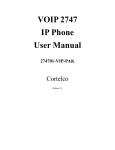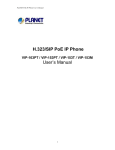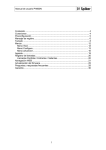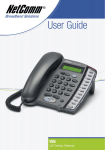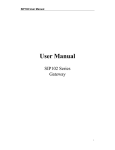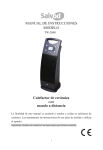Download Cortelco VOIP 2747 User manual
Transcript
VOIP 2747 IP Phone User Manual 274701-VIP-PAK Cortelco Release 4.0 03-2005 Contents 1 OVERVIEW .........................................................................................................4 1.1 1.2 1.3 2 INTRODUCTION ...............................................................................................4 KEY FEATURES................................................................................................4 HARDWARE SPECIFICATION .............................................................................7 BASIC INSTALLATION ....................................................................................8 2.1 APPEARANCE INTRODUCTION .........................................................................8 2.1.1 Key parts of the 2747 .............................................................................8 2.1.2 Rear and Back side Panel of the 2747 ...................................................9 2.1.3 KEYPAD DEFINITION ........................................................................................10 2.2 LCD MENU LIST ...........................................................................................14 2.3 3 INSTALLATION ENVIRONMENT ......................................................................18 CONFIGURATION FROM KEYPADS ..........................................................19 3.1 NETWORK CONFIGURATION ..........................................................................19 3.1.1 Dynamic IP Method (DHCP)...............................................................19 3.1.2 PPPoE Method.....................................................................................20 3.1.3 Static IP Method...................................................................................20 3.2 REGISTRATION TO GK / PROXY SERVER ........................................................21 3.2.1 Registration to a gatekeeper (H.323 version)......................................21 3.2.2 Registration to a proxy server (SIP version)........................................22 3.3 REGISTRATION / STARTUP MESSAGE ..............................................................23 3.4 CALL FORWARD CONFIGURATIONS ...............................................................26 3.4.1 Immediate Forward..............................................................................26 3.4.2 Busy Forward.......................................................................................27 3.4.3 No Answer Forward.............................................................................27 3.5 CONFIGURATIONS UNDER “VIEW” ITEM ........................................................27 3.5.1 View current network settings ..............................................................27 3.5.2 Ping another device .............................................................................28 3.5.3 Restart ..................................................................................................28 3.5.4 Display current software version .........................................................28 3.5.5 Packet Trace for signal monitoring .....................................................28 4 WEB CONFIGURATION.................................................................................29 4.1 NETWORK CONFIGURATION ON WEB .............................................................30 4.1.1 Basic.....................................................................................................30 1 4.1.2 Others...................................................................................................30 4.1.2.1 MAC Address...................................................................................30 4.1.2.2 NTP Server.......................................................................................30 4.1.2.3 Time Zone ........................................................................................30 4.2 H.323 CONFIGURATION ON WEB ...................................................................31 4.2.1 H.323 Parameters ................................................................................31 4.2.2 Forward Mode .....................................................................................31 4.2.3 Advanced..............................................................................................31 4.2.3.1 Min Media Port :..............................................................................31 4.2.3.2 Max Media Port : .............................................................................32 4.2.3.3 Codec : .............................................................................................32 4.3 SIP CONFIGURATION ON WEB ........................................................................32 4.3.1 SIP Parameters ....................................................................................32 4.3.2 Forward Mode .....................................................................................33 4.3.3 Advanced..............................................................................................33 4.3.3.1 Reg From .........................................................................................33 4.3.3.2 Reg To ..............................................................................................33 4.3.3.3 Reg Expire .......................................................................................33 4.3.3.4 Min Media Port ................................................................................33 4.3.3.5 Max Media Port ...............................................................................33 4.3.3.6 Codec ...............................................................................................33 4.4 PHONE CONFIGURATION ON WEB ..................................................................34 4.4.1 Prefix....................................................................................................34 4.4.2 Voice.....................................................................................................35 4.4.2.1 Ring Volume ....................................................................................35 4.4.2.2 Handset Volume ...............................................................................35 4.4.2.3 Handfree Volume .............................................................................35 4.4.2.4 CodecTxGain ...................................................................................35 4.4.2.5 Ring Type.........................................................................................35 4.4.2.6 RTPLowBW.....................................................................................35 4.4.2.7 Jitter Buffering .................................................................................35 4.4.3 Others...................................................................................................36 4.4.3.1 VAD .................................................................................................36 4.4.3.2 BG Noise Level................................................................................36 4.5 SYSTEM CONFIGURATION..............................................................................36 5 CALL FUNCTIONS ..........................................................................................37 5.1 5.2 MAKING CALLS ............................................................................................37 RECEIVING CALLS.........................................................................................37 2 5.3 CHECK CALL HISTORY (INCOMING / OUTGOING / MISSED CALLS) ...................37 5.4 REDIAL .........................................................................................................38 5.5 CALL FORWARD ............................................................................................38 5.6 CALL TRANSFER ...........................................................................................38 5.6.1 Blind Transfer ......................................................................................38 5.6.2 Attended Transfer.................................................................................38 5.7 CALL HOLD...................................................................................................39 5.8 6 PHONE BOOK AND SPEED DIAL ............................................................39 ATTACHMENT .................................................................................................40 6.1 HOT KEY DEFINITIONS..................................................................................40 H.323 INTEROPERABILITY LIST.................................................................................41 6.2 SIP INTEROPERABILITY LIST .........................................................................42 3 1 Overview 1.1 Introduction Cortelco Inc. and its suppliers believe that the next generation of networks based on VoIP technologies will significantly change the way people communicate with each other. To get the greatest benefit from these technologies, the use of VoIP should be simple to most users. Our mission is to make your VoIP experience just as straightforward as using a normal telephone set. The VOIP 2747 is a next generation IP Phone that provides a cost-saving solution for small business/home users for their telecommunication needs. The VOIP 2747 follows the open standard SIP/H.323 protocols to make sure that the user can easily install this IP phone on most of the existing VoIP (Voice over IP) services. By using state-of-the-art DSP (Digital Signal Processing) technology, the VOIP 2747 delivers outstanding voice quality that is comparable to PSTN. With the built in LCD display, the user can easily configure the VOIP 2747 for first time installation in just a few minutes. In addition to the advanced VoIP functions and easy installation, the VOIP 2747 also provides rich telephone features such as last number redial, speed dial, call forward/transfer, call history, volume adjustment and speakerphone. Cortelco’s VOIP 2747 is your best VoIP solution for the next generation of communication. 1.2 Key Features • H.323 version 4 standard : o • RFC-3261 SIP standard : o • Supports Fast start, Tunneling and H.245 DTMF relay. Supports password authentication using MD5 digest and RFC-2833 for DTMF relay. Dynamic IP support (DHCP and PPPoE) : 4 o • Pass through NAT devices: o • FTP protocol provides reliable remote upgrade via Internet. Advanced Digital Signal Processing (DSP) technology to ensure superior audio quality: o • Can make outgoing and incoming calls under any NAT device (even under two layer NAT devices) when working with the specific gatekeeper/proxy device. Remote software upgrade capability (via ftp): o • Gets IP from DHCP server using DHCP protocol or through ADSL modem using PPPoE protocol, automatically reconnects when PPPoE loses connection. Hardware System on a Chip solution with built in DSP processor ensures perfect voice quality. Supports G.723.1, G.729A/B, G.711 (A-law/U-law) voice codecs : o Follows ITU-T standard for best compatibility. • Supports supplementary services, including immediate (unconditional) call forwarding, busy call forwarding, no answer call forwarding and call hold/transferring. • Provides call history: o Records incoming call history, outgoing call history, missed (not accepted) call history, and lets users make a direct call from the call history log. • Phone Book : 50 entries • Speed dial : 10 entries • Supports Silence Suppression, VAD (Voice Activity Detection), CNG (Comfort Noise Generation) : o • Ping function supported : o • Silence suppression can save about half of the network bandwidth needed during normal VoIP conversation. Pings another device on the Internet from the VOIP 2747 to make sure the Internet connection is ok. System status display on the LCD panel : 5 • o User can easily observe if the VOIP 2747 is working normally and monitor the system status (network status, registering status) from the LCD panel display. o A “PKT Trace” function is supported to display the packets received on the LCD panel and helps network administrator find the problem on line. Call with or without gatekeeper / proxy(direct IP dialing) : o • Follows standard SIP / H.323 protocol and is compatible with most existing SIP proxy / H.323 gatekeepers. Provides easy configuration methods: o Setting by keypads on the phone. o Setting by web browser. • Supports RFC-3261, H.323, TCP/UDP/IP, RTP/RTCP, HTTP, ICMP, ARP, DNS, DHCP, NTP/SNTP, FTP, PPP, PPPoE, STUN protocols. • Interoperable with most of the existing SIP/H.323 VoIP devices (IP-phone, gateway, gatekeeper, proxy, soft-switch, IP-PBX), including Microsoft NetMeeting, Cisco gateways / gatekeepers: o • Please refer to the section 6.2/6.3 Interoperability List for a complete listing. The WAN Port works with either straight through or crossover Ethernet cable. 6 1.3 Hardware Specification HARDWARE SPEC Spec\Model VOIP 2747 PC Port 1xRJ45 10/100 Base-T Ethernet, line auto-sensing/switching. WAN Port 1xRJ45 10/100 Base-T Ethernet, line auto-sensing/switching. LCD display 2x16 characters Phone Case 36-button keypad Input: 100-240V AC Universal Switching Power Adaptor Output: +7V DC, 800mA 8 Ohm/0.2 Watt speaker for speakerphone operation Speaker 19cm(W)x23cm(D)x9cm(H) Dimension 870 g Weight Operating Temperature Humidity EMI Compliance 32 - 104°F (0 – 40°C) 10%-95% (non-condensing) UL/EN/FCC Class B Table 1. Hardware Specification of VOIP 2747 7 2 Basic Installation 2.1 Appearance Introduction 2.1.1 Key parts of the VOIP 2747 The key parts of the VOIP 2747 series IP Phone are shown in figure 1, and include the following: 1. 2x16 LCD Display 2. Keypad 3. Usage Indicator 4. User Manual 5. Handset 6. Ethernet Cable 7. Power Adaptor 1. 7. 2. 3. 6. 5. 4. Figure 1. Key parts of the VOIP 2747 series IP Phone 8 2.1.2 Rear and Back side Panel of the VOIP 2747 The rear and back side panel illustration is shown in figures 2 and 3; main parts include: 1. RJ-45 Ethernet Port 2. RJ-45 Ethernet Port 3. Power Adaptor Jack 4. Handset Jack 3. 2. 1. Figure 2. Rear Panel of the IP Phone 4. Figure 3. Back Side Panel of the IP Phone 9 2.1.3 Keypad Definition Figure 3. Keypad illustration 1. Light The red light blinks when there is an incoming call and provides Message Waiting indication. 2. LCD Display Menu and all status displays for user. 3. “Í UP” Key When the IP phone is in the menu selection mode, this key is used to scroll up the menu items. When the IP phone is editing menu item contents, this key is used as “ left delete” to delete a digit upon each key press. When the IP phone is in dial mode, the “Å” key is used as “delete” key. 10 “Æ DOWN” Key When the IP phone is in the menu selection mode, this key is used to scroll down the menu items. When the IP phone is editing menu item contents, this key is used as “ right shift” to shift the cursor right a digit for each key press. 4. - IN VOL+ When the IP phone is in an idle state or user is talking on handset or speaker, this key is used to increase/decrease the volume of the incoming voice. The volume of speaker, handset and ring are separately adjusted according to the mode of current usage. When in idle, “+” key increases the volume of the ring tone, and “-” key decreases the volume of the ring tone; in hands-free mode, “+” key increases the speaker volume, and “-” key decreases the speaker volume; when in handset mode, “+” key increases the volume of handset, “-” key decrease the volume of handset. 5. +OUT VOLUsers are able to increase and/or decrease the volume which they transmit out to a remote party. 6. SPEAKER This key is pressed to switch between the using the handset and the speaker. 7. HOLD This key places conversation on hold. Also see Section 5.6.2. 8. NET When users are not successfully registered to their service provider, this button light will blink. User can press this button to try to register again to their service provider. 9. MESSAGE This key allows retrieval of Voice Mail messages. 11 10. Menu / OK When the IP phone is in idle state, this key is used as a “Menu” key to bring up the menu selection on the LCD display. When inside the menu selection/setting on the LCD display, this key is used as an “OK” key to enter into a lower level of menu selection or to accept the edited item’s contents. When the IP phone is in dial mode, the “OK/Menu” key is used as a “Dial Out” key. 11. Cancel When the IP phone is in the menu selection, this key is used to escape to an upper level of the menu selection. When the IP phone is in menu edit mode, this key is used to cancel current edit and escape to an upper level of the menu selection. 12. TXT ←→ NUM When users need to enter information in text characters, press this button and the alphabet shown on the keypads will be displayed. 13. TRANSFER See Section 5.6. 14. Redial / Dial When the IP phone is off-hook and a number is dialed, this key is pressed to call out. The “#” key will also perform this function on many systems. When the IP phone is off-hook and this key is pressed immediately, the last dialed number will be called out right away. 12 15. Speed Dial M1 – M10 Users are able to store 10 specific phone numbers in the slots of M1 - M10. Users are able to make a speed dial call to the specific party by pressing the speed dial key from M1 – M10. 16. Phone Book Users are able to store up to 50 phone numbers by pressing the “Phonebook” button. For each item of the 50 phone book numbers, the user can store both the number and the name for display. 13 2.2 LCD Menu List The following is the roadmap for the menu on your IP phone: (SIP & H.323 share a similar menu, different parts are written separately.) View ¾ Network Value ¾ IP Address ¾ Network Mask ¾ Default Route ¾ DNS Server ¾ Ping ¾ Restart ¾ Image Version ¾ (Yes / No) PKT Trace Configure (Password: 135) ¾ Network ¾ (Yes / No) Dynamic IP ¾ (Yes / No) PPPoE ¾ If yes: ¾ PPPoE User Name ¾ PPPoE Password ¾ Static IP ¾ IP Address ¾ Network Mask ¾ Default Route ¾ DNS Server ¾ Time Zone ¾ H323 ¾ ¾ ¾ ¾ ¾ Number Password H.323 ID (Yes / No) Reg to GK (Yes / No) RTPLowBW 14 ¾ SIP ¾ ¾ ¾ ¾ ¾ Disp Name Login ID Number Password (Yes / No) Proxy On ¾ If Yes: ¾ Proxy Address ¾ Proxy Port ¾ (Yes / No) Outbound Proxy ¾ If Yes: ¾ Outbound Proxy IP ¾ Outbound Proxy Port ¾ (Yes / No) RTPLowBW ¾ Forward Mode ¾ (Yes / No) Immediate ¾ If Yes: ¾ Immediate Number ¾ (Yes / No) Busy ¾ If Yes: ¾ Busy Number ¾ (Yes / No) No Answer ¾ If Yes: ¾ No Answer Number ¾ No Answer Time Advanced ¾ System ¾ DSP Version ¾ Upgrade / DnLoad ¾ FTP Server IP ¾ Image File Name ¾ Upgrade Image ¾ Upgrade Loader ¾ Config Profile ¾ Debut Mode ¾ Dump Address ¾ Dump Size 15 ¾ Dump! ¾ Network ¾ MAC Address ¾ NTP Server ¾ Restart Count ¾ RTP Process ¾ (Yes / No) Bypass Server ¾ (Yes / No) Jitter Buffer ¾ (Yes / No) Auto Upgrade ¾ Phone Advanced ¾ Codec ¾ G.711u ¾ G.711a ¾ G.729 ¾ G.723 ¾ Voice ¾ (Yes / No) VAD ¾ BG Noise Level ¾ Volume ¾ Ring Volume ¾ Handset Volume ¾ Hand free Volume ¾ Codec Tx Gain ¾ Scrn Con (0-9) ¾ Ring Type (1-10) ¾ UI Mode ¾ Console ¾ Lcd ¾ Both ¾ SIP Advanced ¾ Protocol ¾ Min Media Port ¾ Max Media Port ¾ Reg From ¾ Reg To ¾ Reg Expire ¾ Reg Action ¾ Local Port 16 ¾ User Setting ¾ Platform ¾ Billing Server ¾ Login ¾ User Name ¾ Password ¾ Confirm Password ¾ Statistics ¾ User Statistics ¾ User Statistic ¾ Phone Statistic ¾ Phone Statistics ¾ Call Missed ¾ Call Received ¾ Call Dialed ¾ Additional ¾ International ¾ My Country Code ¾ Area Prefix Code 17 2.3 Installation Environment Figure 4. Installation Environment Step 1: Connect your IP phone to its handset by plugging one end of the coil cord into the handset and the other end into the jack on the bottom of the IP phone. To connect to the internet, plug into the middle jack on the back of the IP phone. This jack is marked WAN. See figure 4 above Step 2: If you would like to have your PC online at the same time, please connect the far right port to your PC. This Jack is marked PC. See figure 4 above. Step 3: Please plug in your power adaptor to your IP phone and power source. LCD of your IP phone will display “Starting…….” and then “SIP / Hi xxx” menu within approximately 4 seconds. 18 3 Configuration from Keypads The VOIP 2747 series IP Phone is designed to be installed easily and is very user-friendly so almost all the configurations can be done through the keypad and LCD screen display on the phone set in a few minutes. In order to make a VoIP call, please configure through the keypad as described in the following few sections: Notice: (1). When needing to input a character in any menu item, please press that key button quickly to switch between different characters to set the correct one. (2). When the input mode is in digit mode (you can only input ‘0’ – ‘9’ and ‘*’, ‘#’), and you want to input a character, please press “TXT ←→ NUM” key first to toggle to “character” input mode. 3.1 Network Configuration The first step in using the VOIP 2747 IP Phone is to set the network configuration to let the IP Phone connect to internet. This step depends on your network environment and phone models, so please use the proper method in configuring the IP Phone for your internet connection. 3.1.1 Dynamic IP Method (DHCP) Most of the network environment in an office, hotel room or at home is under a NAT (IP sharing)/router device. Under this environment, the easiest way to connect to internet is using DHCP. The IP Phone, when configured using the following method, will get the IP parameters dynamically, and connect to the internet automatically. Configure ► Password:135 ► Network ► (Yes/No) Dynamic IP Please press “ok” key to set Yes on (Yes / No) Dynamic IP when using DHCP. Most cable modem connections also use DHCP. 19 3.1.2 PPPoE Method Many of the broadband network connections now provided are ADSL connections. Under this environment, the IP Phone can directly connect to the ADSL modem by setting the PPPoE account (user name and password) provided by the ADSL service provider. Configure ► Password:135 ► Network ► (Yes/No) PPPoE Please press “ok” key to set Yes on (Yes/No) PPPoE when using PPPoE method, then key in the account from the ISP. PPPoE Username – please input the user name of the account given by your ADSL ISP. PPPoE Password – please input the password of the account given by your ADSL ISP. 3.1.3 Static IP Method For the other network environments, the users will need to set the static IP provided by their ISP or from the office MIS representative. Configure ► Password:135 ► Network ► Static IP Under the “Static IP” submenu, please key in the IP address, network mask and default router settings provided by your ISP or a private IP address. Once all the network settings are complete, please restart your IP phone. To check whether your internet connection is working properly, go to View Æ Ping, then key in a public IP address to ping it. If the response is ok, then the network settings are complete. 20 3.2 Registration to GK / Proxy Server After the network environment is set and connected to the Internet, you can register the IP Phone to your H.323 gatekeeper or SIP Proxy server. Please choose one of the following methods to register to a gatekeeper or proxy server. (Method depends on your IP Phone model) 3.2.1 Registration to a gatekeeper (H.323 version) When the VoIP vendor/operator is running the H.323 system, use the VOIP 2747 to register to the gatekeeper. Configure the following parameters to do the registration. Configure ► Password:135 ► H323 A. Number – please input the phone number to register to the gatekeeper. B. Password – please input the password to register to the gatekeeper. This password is carried in the H.235 message for authentication purpose. (Not every gatekeeper needs this field, if not needed, keep it empty.) C. H323_ID – please input the H.323 ID to register to the gatekeeper. (Not every gatekeeper needs this field, if not needed, keep it empty.) D. (Yes/No) Reg To GK – please select Yes and register to the gatekeeper. The gatekeeper IP address is not configurable at the keypad if this IP Phone is provided by the vendor/operator. If you really want to change this setting, please go to “web settings” and change it under the H.323 web configuration page. If the IP Phone does not register to any gatekeeper, it can still call to other IP phones by calling the IP address directly. E. (Yes/No) Full RRQ – whether to register with full RRQ(* Default (No))。 In a normal situation, the IP Phone will automatically re-register to the gatekeeper periodically with minimum information to keep the connection 21 alive. Some gatekeepers require the devices to keep re-registering to it using the full information, in this case, please set the “FullRRQ” to “Yes”. Note: The VOIP 2747 can pass the NAT/router devices if the gatekeeper supports this function. The IP Phone will automatically detect if the gatekeeper supports this and do the proper configuration to work under this NAT environment. 3.2.2 Registration to a proxy server (SIP version) When the VoIP vendor/operator is running the SIP system, use the VOIP 2747 to register to the proxy server. Configure the following parameters to do the registration. Configure ► Password:135 ► SIP A. Number – please input the phone number (username) to register to the proxy server. B. Password – please input the password to register to the proxy server. This password is carried in the SIP Proxy-Authorization field using MD5 digest method for authentication purposes. Not every proxy server needs this field; if not needed, keep it empty. Cortelco’s VOIP 2747 follows the standard RFC-2617 to do the authentication. C. Login ID – please input the username for registration authorization. When the IP Phone is registering to the proxy server, the Authorization field will have the username=”xxxxx” field; if the “Login ID” entry is empty, the username will use the “Number” input value, but when the “Login ID” field has some value, the username will use this “Login ID” value for authorization. D. (Yes / No) Proxy On – please select Yes and register to the proxy server. After this item is enabled, two more menu items will appear. One is the proxy server address, to set the IP address or domain name address of the 22 proxy server. Another is the proxy server port, to set the port of the proxy server; its value is usually 5060 unless specified by the service vendor. If the IP Phone does not register to any proxy server, it still can call to another IP phone by calling the IP address directly. E. (Yes / No) Outbound Proxy – please set this item to Yes if the registration needs to pass through the Outbound Proxy server. 3.3 Registration / Startup message When the network and registration configurations are set, please restart the IP Phone. The LCD display on the IP phone will show one of the following messages: (depends on whether the registration is ok or not.) (a). When the IP Phone is registered to a H.323 gatekeeper successfully, the LCD screen will display the following message: Hi (number) Date Time This means that the VOIP 2747 is working OK and is ready for outgoing/incoming calls. The number inside braces () is the IP phone’s number. Hi (GK Off) Date Time This means that the VOIP 2747 is working OK and is ready for outgoing/incoming calls. However, if the “Reg to GK” flag is “No”, then the IP Phone does not need to register. In this case, you can call the IP address of other IP Phone directly. (b). When the IP Phone is registered to a SIP proxy server successfully, the LCD screen will display the following message: SIP (number) Date Time 23 This means that the VOIP 2747 is working OK and ready for outgoing/incoming calls. The number inside braces () is the IP phone’s number. SIP (Proxy Off) Date Time This means that the VOIP 2747 is working OK and ready for outgoing / incoming calls. If the “Proxy On” flag is “No”, then the IP Phone does not need to register. In this case, you can call the IP address of another IP Phone directly. (c). When the IP Phone is configured to use a gatekeeper or proxy server, but has not yet registered successfully or failed, the LCD screen will display the following message: Registering (number) Date Time When the “Registering” message is displayed, the IP phone can not make any calls. The menu selection and the on-hook / off-hook function will work OK. (d). If the IP Phone failed in registering to a H.323 gatekeeper or SIP proxy server, the LCD screen will display the following message: RegFail (failed message) Date Time The failed message could be one of the following: (1). Duplicate: this means that the registering number is duplicated with others, or the IP Phone’s previous registration information is still kept in the gatekeeper/proxy server if not unregistered last time (this could happen when the IP Phone is powered off instead of restarted from the menu item). If the previous registration information is not cleared, you may need to wait about 4 minutes to let the IP Phone register successfully again. 24 (2). Security : this means that the account (username / password / H.323 ID) is not correct, please check your account again. When the RegFail message is displayed, the IP phone can not make any calls. The menu selection and the on-hook / off-hook function will work OK. (e). When the IP Phone fails in obtaining an IP address from the DHCP server, the LCD screen will display the following message : DHCPFail (number) Date Time This means that the IP phone is configured to use DHCP to get an IP address, but the DHCP procedure failed (cannot find a DHCP server or the DHCP server rejected the IP assignment). The IP phone can not make any calls and the on-hook / off-hook functions will not work, you can not hear any sound on the handset or the speaker. Only the menu selections will work. The IP phone will continuously try to get the IP address from the DHCP server, so, if the DHCP server is responding, the DHCPFail () display will change to Hi() display to notify that the IP phone is working OK. (f). When the IP Phone is set to use the PPPoE method for network connection, but has some problem in finding the PPPoE server (ADSL modem), the LCD screen will display the following message : PPPoE FindFail(number) Date Time This means that the IP phone is configured to use PPPoE to get an IP address, but the PPPoE procedure failed (can not find a PPPoE server or the network connection has a problem). The IP phone can not make any calls, but the menu selection and the on-hook / off-hook function will work OK. (g). When the IP Phone is set to use the PPPoE method for network connection, 25 but has some problem in the PPPoE account, the LCD screen will display the following message: PPPoE AuthFail (numer) Date Time This means that the IP phone is configured to use PPPoE to get an IP address, but the PPPoE server refuses the connection because the username/password is not correct. The IP phone can not make any calls, but the menu selection and the on-hook / off-hook function will work OK. (i). When the IP Phone is enabled to “Immediate Forward”, the LCD screen will display the following message : FWD(number) Date Time This means that the VOIP 2747 is working OK and ready for outgoing/incoming calls. For any incoming call, it will be forwarded to the “Immediate Forward Number”, and this IP Phone will not ring. See Sect. 3.4. 3.4 Call Forward Configurations The phone supports three different Call Forwarding modes. selected using the “Configure”Æ”Forward Mode” option. These modes are 3.4.1 Immediate Forward To enable Immediate Forward mode, Press MENU/OK with Item 1 Immediate selected. The display will change to 1. (Yes) Immediate and 2. Immed Number will appear. Press DOWN Then MENU/OK to enter the target number for Immediate Forwarding. The display will show Immed Number =. Enter the number using the keypad and press MENU/OK. Then press CANCEL three times. The display will show FWD(Ext Number). If Immediate forwarding is selected, all calls to the phone will be sent to the target number. When Immediate Forwarding is enabled, Busy Forward and No Answer Forward can not be enabled. 26 3.4.2 Busy Forward To enable Busy Forward mode, Press MENU/OK with Item 2 Busy selected. The display will change to 2 (Yes) Busy and 3. Busy Number will appear. Press DOWN Then MENU/OK to enter the target number for Busy Forwarding. The display will show Busy Number =. Enter the number using the keypad and press MENU/OK. Then press CANCEL three times. The display will show SIP(Ext Number). If Busy forwarding is selected, all calls to the phone will be sent to the target number when the phone is in use. 3.4.3 No Answer Forward To enable No Answer Forward mode, Press MENU/OK with Item 3 No Answer selected. The display will change to 3 (Yes) No Answer and 4. NoAns Number will appear. Press DOWN Then MENU/OK to enter the target number for No Answer Forwarding. The display will show NoAns Number =. Enter the number using the keypad and press MENU/OK. Then press CANCEL. Now Press DOWN and then MENU/OK to enter the No Answer time. This sets the amount of time in seconds before the call will be forwarded if it is not answered. Enter the time and press CANCEL three times. The display will show SIP(Ext Number). 3.5 Configurations under “View” item Under the “View” menu item, there are many submenu items. These are mainly for information about the phone’s current status, but they also provide simple functions to check the status of the network. 3.5.1 View current network settings By selecting “View”Æ”Network Value”, it is possible to see the current IP Address, network mask, default router and DNS server address. The phone may get its IP address from DHCP or PPPoE or it may have a static address. The “View”Æ”Network” menu allows the user to determine the actual IP address. 27 3.5.2 Ping another device The “Ping” function is one of the most commonly used tools to determine the state of a network connection. By selecting “View”Æ”Ping” and keying in the IP address or domain name of another device, the phone can check the status of its connection to that device. This can also be used to check the status of the Internet connection by pinging another device that is already on the public Internet. 3.5.3 Restart By selecting “View”Æ”Restart”, the VOIP 2747 will perform a “warm restart.” This will unregister the phone from the gatekeeper or proxy server, and will also disconnect the modem connection if a modem is connected. 3.5.4 Display current software version By selecting “View”Æ”Image Version”, the phone will display the current software version. The software version is identified by the date of the release of the software image. 3.5.5 Packet Trace for signal monitoring Setting the “View”Æ”PKT Trace” to (Yes) will cause the phone to display all the signaling messages received on the LCD screen. This may be useful for debugging. 28 4 Web Configuration The phone provides a web interface for configuration. Please note that the web interface will only work with Internet Explorer. To use this configuration method, enter the IP address of the phone into the browser address bar. The following login window will appear: Username: root Password: **** enter The default username is “root”, and the default password is “1234”. Please type these into the boxes shown and then click the “enter” button or press Enter on your keyboard. This will bring up the home page of the phone as shown below. This page provides basic information and also allows selection of additional pages for more detailed configuration. 29 4.1 Network Configuration on web Clicking on the “Network” icon on the left banner will bring up following page to allow network configuration. 4.1.1 Basic Please see section 3.1 for an explanation of each field. 4.1.2 Others 4.1.2.1 MAC Address View the MAC Address of the IP Phone. The MAC Address cannot be changed at this screen. 4.1.2.2 NTP Server Set the NTP (Network Time Protocol) server’s IP Address. phone can use NTP to display the current date and time. The 4.1.2.3 Time Zone Used to specify the time zone. 30 Clicking the “View” icon will display a list of all available time zones. should be set to -6 for US Central Time. For example, the value 4.2 H.323 Configuration on web Clicking on the “H.323” icon on the left banner will display the following page to allow configuration of H.323 related parameters. 4.2.1 H.323 Parameters Please see section 3.2 for the explanation of each field. 4.2.2 Forward Mode Please see section 3.4 for the explanation of each field. 4.2.3 Advanced 4.2.3.1 Min Media Port : The minimum value of the range of the transmitted RTP packet’s port. 31 4.2.3.2 Max Media Port : The maximum value of the range of the transmitted RTP packet’s port. 4.2.3.3 Codec : The type of the Codec of the transmitted RTP packets. 4.3 SIP Configuration on web Clicking on the “SIP” icon on the left banner will display the following page to allow configuration of SIP related parameters. 4.3.1 SIP Parameters Please see section 3.2 for an explanation Fields 1 – 10. Fields 11,12 , and 13 enable the 2747 to support STUN (Simple Traversal of User 32 Datagram Protocol (UDP) Through Network Address Translators (NAT)). To enable STUN, select Item 11, then click the SET button. After a moment, the STUN Address box and the STUN Server Port box will become available for typing. Enter the desired STUN server address and the STUN server port, then press SET again. 4.3.2 Forward Mode Please see section 3.4 for an explanation of each field. 4.3.3 Advanced 4.3.3.1 Reg From Modifies the “From:” field in the SIP / SDP messages. This field should be left empty in most cases. 4.3.3.2 Reg To Modifies the “To:” field in the SIP / SDP messages. This field should be left empty in most cases. 4.3.3.3 Reg Expire Modifies the “Expires:” field in the SIP/SDP messages. This will control the re-registration period. 4.3.3.4 Min Media Port The minimum value of the range of the transmitted RTP packet’s port. 4.3.3.5 Max Media Port The maximum value of the range of the transmitted RTP packet’s port. 4.3.3.6 Codec The type of codec used to transmit RTP packets. In SIP calls, the type of codec used is determined by the called party. 33 4.4 Phone Configuration on web Clicking on the “Phone” icon will display the following page to allow configuration of phone related parameters. 4.4.1 Prefix The first three entries in this section are used for VoIP systems which require special treatment of country codes, international codes, and area codes. Any numbers placed in the “My Country Code” and “Area Prefix Code” boxes will be appended to the front of dialed numbers. Any numbers placed in the “International Code” box will be removed from the front of dialed numbers. In most cases, these values are not needed and the boxes should be left empty. The Message Number entry is the number which will be dialed by the MESSAGE button. Normally this would be the voice mail access number. 34 4.4.2 Voice 4.4.2.1 Ring Volume Adjusts the volume of ringing. 4.4.2.2 Handset Volume Adjusts the volume of incoming calls on the handset. 4.4.2.3 Handfree Volume Adjusts the volume of incoming calls on the handsfree. 4.4.2.4 CodecTxGain Adjust the output voice volume. 4.4.2.5 Ring Type Changes the ringing type(ring pattern) of an incoming call. 4.4.2.6 RTPLowBW Checking this box will cause the phone to decrease the voice packet bandwidth in the transmit direction. This should only be used if the internet bandwidth is not good enough to support normal packet bandwidth. 4.4.2.7 Jitter Buffering Checking this box will increase the jitter buffer from 150ms to 400ms. This may improve the received voice quality in some internet connections. 35 4.4.3 Others 4.4.3.1 VAD Checking this box will enable Voice Activity Detection. With this feature enabled, the phone will detect if the user is talking and will not send packets when the user is silent. This can help to decrease the bandwidth requirement. 4.4.3.2 BG Noise Level This value controls the sensitivity of the VAD detection. 4.5 System Configuration Clicking on the “System” icon will display the following page to allow configuration of system related parameters. This page allows software upgrades, username/password changing, and rebooting (restarting). 36 5 Call Functions 5.1 Making Calls To make a call, pick up the handset or press the SPEAKER button, dial the called party’s number, and end with “#” key or RE/DIAL. 5.2 Receiving Calls To answer a call when the phone is ringing, pick up the handset or press the SPEAKER button. 5.3 Check call history (incoming / outgoing / missed calls) The call history can be displayed on the LCD screen by pressing the “Å” key or the “Æ” key when the phone is idle. There are three kinds of call history: Incoming is the record of numbers and time of the last 10 incoming calls when answered Outgoing is the record of numbers and time of the last 10 successful outgoing calls. Missed is the record of numbers and time of the last 10 incoming calls that were not answered When viewing the call history, press the “MENU/OK” key to do one of the following three actions: 1.Dial – To call the number press the “MENU/OK” key again. 2.Delete – To delete this item from the call history press the DOWN key and then press “MENU/OK” 3.To Phone Book – To add this item to the phone book, press the DOWN key twice and then press “MENU/OK” Name = will appear on the display. A name can be added to this number by using the keypad. When finished, press MENU/OK and the added item will be sorted alphabetically in the phone book. 37 5.4 Redial To call the last dialed number (redial), press the “RE/DIAL” key immediately after going off-hook. 5.5 Call Forward Call forwarding functions can be set via the keypad or by web configuration. Please refer to section 3.5 for more details. 5.6 Call Transfer This phone supports three types of call transfer. They are ringing transfer, blind transfer and attended transfer. 5.6.1 Ringing Transfer When a call is incoming and the IP phone is ringing, by pressing the “Transfer” key and then another IP phone’s number you can transfer the call immediately to another party without answering the call. 5.6.2 Blind Transfer With blind transfer, the caller is transferred to a third party without informing the third party who is transferring the call. Example: A calls B and A wants B to transfer the call to C. B presses the “TRANSFER” button and waits to hear dial tone. Then B dials C’s number and hangs up. A is now transferred to C. 5.6.3 Attended Transfer With attended transfer, the caller is transferred to a third party after the third party is informed. Example: A calls B and A wants B to transfer the call to C. B presses the “HOLD” and waits for dial tone. Then B dial the C’s number and waits for C to answer. B can now inform C of the call transfer. When B hangs up, A is transferred to C. 38 5.7 Call Hold As described above, the HOLD button allows attended transfer. If the number of the third party is not dialed in 8 seconds, the phone will go into the “Hold” state. By pressing HOLD again, the call can be continued 5.8 Phone Book and Speed Dial 5.8.1 Phone Book The Phone Book allows 50 names and numbers to be stored. To access the Phone Book press the “PHONE BOOK” button, the display shows 1.Phone Book 2.Speed Dial. Press “MENU/OK.” The display now shows 1.Add, 2.Edit, 3.Delete, 4.Delete All 5.8.1.1 Add After selecting the Phone Book, press “MENU/OK” to select Add. The display will show “Name=”. Use the keypad to enter the name and press “MENU/OK”. The display now shows “Number=.” Use the keypad to enter the number and press “MENU/OK.” Press “CANCEL” twice to return to the idle state. 5.8.1.2 Edit After selecting the Phone Book, press “DOWN” and then “MENU/OK” to select Edit. The display will show all the entries in the Phone Book in alphabetical order. Used the “UP” and “DOWN” keys to scroll to the desired name and press “MENU/OK”. The display now shows 1.Name 2.Number. To edit the name, press “MENU/OK”. To edit the number, press “DOWN” and then press “MENU/OK”. After pressing “MENU/OK” the display will show the current information stored for the name or number. Use the UP and DOWN keys and the keypad to make changes, then press “MENU/OK.” Press “CANCEL” four times to return to the idle state. 5.8.1.3 Delete After selecting the Phone Book, press “DOWN” twice and then “MENU/OK” to select Delete. The display will show all the entries in the Phone Book in alphabetical order. Used the “UP” and “DOWN” keys to scroll to the desired name and press “MENU/OK” to delete this entry. The display will now show the new Phone Book list. Press “MENU/OK” to delete another entry or press “CANCEL” three times to return to the idle state. 5.8.1.4 Delete All After selecting the Phone Book, press “DOWN” three times and then 39 “MENU/OK” to select Delete All. The display will show “Are You Sure?”. Press “MENU/OK” to delete all Phone Book entries. Press “CANCEL” twice to return to the idle state. 5.8.2 Speed Dial To access Speed Dial, press the “PHONE BOOK” button, the display shows 1.Phone Book 2.Speed Dial. Press “DOWN” and then press “MENU/OK.” The display now shows the ten speed dial locations M1 through M10. The information in these buttons may be viewed or changed. 5.8.2.1 Speed Dial – View Settings After accessing the Speed Dial, use the UP or DOWN key to select the desired memory location, then press “MENU/OK” twice. The display will now show Current Setting= XXXXX where XXXXX is the name stored in this location. Press “CANCEL” four times to return to the idle state. 5.8.2.2 Speed Dial – Change Settings After accessing the Speed Dial, use the UP or DOWN key to select the desired memory location, press “MENU/OK”. Then press the “DOWN” key. Then press “MENU/OK.” The display will now show a listing of names stored in the phone book. Select the information to be stored and press “MENU/OK.” Press “CANCEL” three times to return to the idle state. 6 Attachment 6.1 Hot Key Definitions The hot key is a sequence of keys pressed when the IP Phone is in idle state. following table defines hot key sequences and their functions. Hot Key #*102* #*103* #*109* #*110* #*111* #*112* #*800* Table 4. Function Test LCD and Keypad Test LCD MAC Check and modify Set to default Upgrade software of ET-747H Upgrade software of ET-747S Clear Gatekeeper IP (for H.323 only) Hot key definitions 40 The H.323 Interoperability List The followings devices that have been tested to be interoperable with the 2747 IP Phone. - Client/Terminal Microsoft NetMeeting, Version 3.01 OpenH323 Phone, Version 1.6.0 WellTech, LANPhone 101 Sagitta IP Phone RadVision H.323v4 Protocol Stack (IMTC 2002) Leadtek Research Inc., BVP8770 Video Phone (IMTC 2002) Sony Electronics, PCS-6000 / PCS-1600 (IMTC 2002) Aethra Srl (Italy), Vega Pro (IMTC 2002) IBM Corporation, Java-based Voice Server (IMTC 2002) First Virtual Communications, Click To Meet Web Endpoint (IMTC 2002) Innovaphone, IP200 (IMTC 2002) UniData iW200 Cisco7905 IP Phone - GateKeeper Cisco AS5350 Gatekeeper function Citron Network Inc. Gatekeeper Radvision ProLab GateKeeper Simulator, Version 1.0, October 2001 OpenH323 GateKeeper, Version 1.3.2 GnuGK III (Institute, Institute for Information Industry) GateKeeper, Version 1.0 NexTone Communications Inc., MSW (IMTC 2002) MediaDigm Technology Inc. (Canada), SureKeeper (IMTC 2002) Lucent iMerge gatekeeper Wintel gatekeeper MKY gatekeeper EZTone gatekeeper Tellink gatekeeper Hivocal gatekeeper GCard gatekeeper 41 - Gateway D-Link 4-port gateway Vanguard Managed Solutions, Vanguard (IMTC 2002) AudioCodes Ltd., MP108 (IMTC 2002) Cisco Systems Inc., Test Bed#1 (IMTC 2002) Polycom Israel, GW-25 (IMTC 2002) Antek Tech., 2~16 port gateway WellTech gateway Quintum gateway - MCU OpenH323 MCU, Version 1.1.3 Polycom Israel, MGC-100 (IMTC 2002) - SoftSwitch ZTE Telcom. Softswitch WalkerSun softswitch 6.2 SIP Interoperability List The following devices have been tested to be interoperable with the 2747 series IP Phone. Client/Terminal -SCS-Client V1.00 -SIPS 2.0.43.11 -SJ-Phone 1.10.187c -X-Lite – FWD V2.0 -Softphone – Simems V0.90Bata27 -Estara V3.0.0.15 -Cisco ATA-186 -Cisco 7905 -BCM SIP Phone -GrandStream SIP Phone Proxy Server -Wparty SIP V0.5.0 -Wparty SIP V0.5.5.2 42 -Asterisk 0.5.0 -Linux – Vovida V1.5 -SER 0.8.10 -WalkerSun softswitch Gentrice proxy server Inphonex platform DeltaThree platform NEC SV7000 IP PBX Trunking Gateway -Cisco 5300 -Quintum D2400 43












































